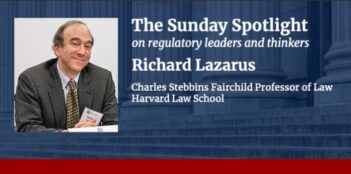
President Obama recently signed toxics reform; now it is time to fix workplace safety law, too.
Earlier this summer, President Obama signed a sweeping overhaul of the Toxic Substances Control Act (TSCA), the law governing how the U.S. Environmental Protection Agency (EPA) evaluates and regulates chemicals. It is a noteworthy occasion any time our deeply polarized Congress can do more than name post offices. Passage of TSCA reform was a particularly remarkable accomplishment because TSCA had not been significantly amended since it was enacted in 1976—even though everyone agreed that the statute was dysfunctional.
The law that protects workers—the Occupational Safety and Health (OSH) Act—is six years older, and only marginally more effective. The TSCA rewrite gives hope for—and ought to inspire—a similar effort to make our workplaces safer and healthier.
Several features of TSCA ensured that it could never work effectively. In a sort of Catch-22, EPA usually had to conclude that a chemical could present an “unreasonable risk of injury” before it could require testing to determine the chemical’s hazardousness—a requirement that could potentially require years of EPA rulemaking procedures. Furthermore, the “unreasonable risk” standard conflated questions of harm to humans or the environment with the potential economic impacts of any restrictions EPA might impose, an overwhelming mix of apples and oranges.
Worse still, when regulating a chemical, EPA had to choose only the “least burdensome” restrictions to impose on industry, a requirement that tripped up government’s effort to regulate asbestos. Any restriction also had to clear trial-like public hearings.
Most fatal to the pre-amendment TSCA, the law did not require EPA to assess or regulate any number of chemicals by any specific date—so EPA rarely did.
However, the new law fixes all of these problems.
When it comes to workplace safety, though, the OSH Act, at least as interpreted by courts and the Occupational Safety & Health Administration (OSHA), creates similar challenges for sensible regulatory policy. The Act requires that a workplace hazard present a significant risk of material health impairment and that OSHA demonstrate that any proposed standard would substantially reduce that risk. OSHA also has to show that any proposed standard is economically and technologically feasible to comply with, which it substantiates to six-digit industry classifications. Like the old TSCA, the OSH Act requires OSHA to hold public hearings before any new standard can be adopted.
These requirements have most notably hobbled OSHA in regulating inhalation hazards. In 1970, Congress required OSHA to adopt several hundred privately derived standards. To date, OSHA has been unable to update more than a handful of these, meaning that most are now almost half a century out of date.
Both EPA and OSHA made their respective situations worse in a variety of ways.
For example, both agencies initially overreached by pushing “no safe dose” arguments about asbestos and benzene, respectively, and got slapped back by courts.
Both agencies then overreacted to those decisions, essentially developing what psychologists call “learned helplessness.” EPA stopped trying to regulate existing chemicals; OSHA became resigned to taking decades to issue standards. Both agencies also effectively painted themselves into regulatory corners through their own statutory interpretations. EPA could justify requiring testing without findings of potential harm if it made alternative findings about production and exposure—but its interpretation of that provision made it barely useful. Even more remarkably, OSHA has imposed upon itself a host of rulemaking procedures—for example, post-hearing briefs—that are not required by law (or even by the agency’s own regulations).
The OSH Act also suffers from flaws that TSCA did not. Most appalling are its criminal penalties. Under its criminal liability provision, an employer who willfully violates an OSHA standard and thereby kills an employee can get, at most, six months of jail time or a $10,000 fine. If the employer does it again, those sanctions are simply doubled. The U.S. Department of Justice’s Environment and Natural Resources Division recently assumed responsibility for prosecuting OSHA criminal cases because sanctions can be so much greater under environmental laws; for example, if a workplace violation involves a knowing release of a hazardous air pollutant, “merely” endangering employees (without killing anyone) can result in a 15-year jail term or a $1 million fine for an organization.
OSHA is also relatively more disadvantaged politically. EPA benefits from strong support by a host of prominent, savvy environmental groups, largely sympathetic media, and powerful allies in Congress. OSHA’s only real allies are unions (who are steadily shrinking in size and influence) and, to a lesser degree, public health academics. As a practical matter, the field of workplace safety and health law is subsumed within the combative and static field of labor law. Industry lawyers used to showing EPA a certain degree of respect are usually shocked by the derisive way many OSHA practitioners treat OSHA.
An amended OSH Act could be oriented primarily toward codifying common best practices on a periodic basis. The concepts of risk and feasibility are necessary to workplace safety and health regulation, but feasibility could certainly be handled more efficiently, potentially on a by-exception basis. Although OSHA should not be forcing technology, its standards need to move out of the vacuum-tube era. Although a new statute will not necessarily solve OSHA’s internal cultural problems, it could inspire a more can-do culture and a sense of urgency.
The prospect of TSCA reauthorization was airily dismissed for years. And yet industry and environmentalists—and Republicans and Democrats—have managed to agree on major changes to the way we study and restrict chemicals. A similarly intensive and even-handed focus on OSHA and the OSH Act could begin to produce some consensus on what features of the law, and what practices of the agency, need to change for OSHA to be able to do its job. We should all want safer workplaces.




